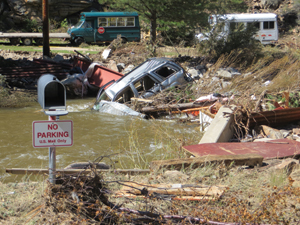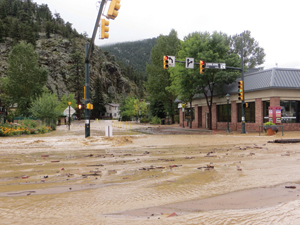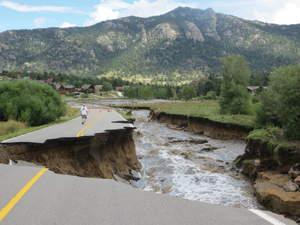Physician Heroes: Finding community amidst a disaster
Colorado Medicine introduces new series profiling physician heroes
Editor’s note: There are several warning signs of professional burnout, including having feelings of being rundown or drained of physical or emotional energy, being easily irritated by small problems, feeling misunderstood or unappreciated by your coworkers, feeling that you’re under too much pressure to succeed, feeling frustrated by organizational politics or bureaucracy, or feeling that there is more work than you practically have the ability to do.
The Colorado Medical Society recognizes the prevalence of burnout among physicians, particularly in this time of great change in health care. To help our members reflect on the meaningful difference you’re making in the lives of your patients and community and to recognize extraordinary actions, Colorado Medicine has launched the new series, Physician Heroes. We will profile as many different members as we can who have gone above and beyond in the profession to help his or her colleagues or community. We hope you’ll see your own values reflected in these stories and be reminded of the joy of medicine.
Members are invited to nominate themselves or a colleague by contacting Dean Holzkamp at dean_holzkamp@cms.org or 303-748-6113.

Historic Estes Park flooding
Disasters can bring out the best – and the worst – in humanity. Colorado Medical Society member Frank Dumont, MD, an internal medicine physician in Estes Park, witnessed the best of humanity and performed at the top of his game during the historic Colorado floods of September 2013.
Dumont practices what he calls “an older version of internal medicine.” While his responsibilities as chief of staff at Estes Park Medical Center have interjected more meetings into his schedule, he still takes care of patients in outpatient and inpatient settings and in the nursing home associated with his clinic. If his patients need hospital care, he sees them there and then follows up with them in his clinic after discharge.
Early in the week when the rain first started, many in Estes Park were relieved as they had struggled with local forest fires for the past two years. Dumont can still recall the beautiful scene of the clouds swirling against the mountain backdrop.

Early Thursday morning around 3 a.m., Dumont called the hospital to check on one of his patients. A nurse told him highways 34 and 36 were shut down. While rockslides, mudslides or snow slides frequently cause a highway to close, it’s uncommon for both major arteries to be shut down at once. At 5 a.m. he received a phone call that school was cancelled. “For rain? That’s a first,” he thought, but went into work as usual.
As the morning progressed, Dumont began to realize the severity of the situation. EPMC is a small, 25-bed community critical access hospital without an ICU and without a full spectrum of specialists, thus patients needing higher levels of care are usually transported by ambulance or sent down to Denver by helicopter.
“Highways 34 and 36 were not only down but were going to be inaccessible for a considerable amount of time. Sections of the road were being washed away with more crumbling by the minute,” Dumont recalled. Highway 7, another of the major roads connecting Estes Park to the outside world, was also compromised. And the remaining road, Trail Ridge, which winds through Rocky Mountain National Park up to a top elevation of 12,000 feet, was intermittently impassible because of freezing precipitation.
“There were times when we were completely isolated, and when we did have a road, it was a six- to seven-hour drive to Denver, where we get most of our supplies. Not only that, but because of all the rain and the cloud cover being so low, we didn’t have any helicopter service either.”
None of the retail pharmacies could open as their staff pharmacists were stranded on the other side of the closed highways; the other two clinics in town also remained closed in the initial days of the disaster. EPMC was suddenly the only source of medical care available for Estes Park and the surrounding communities.

Dumont and the medical staff began to organize. Without functional supply lines for food or medical supplies, they inventoried their pharmaceuticals, medications and antibiotics and crafted a plan to ensure they were using their medications wisely. They made the decision to stop scheduling and providing routine care to preserve limited resources. Dumont and the medical officer for the clinic devised a 12-hour shift rotation to make sure they had adequate hospital coverage. As all phone service and most Internet service was out, staff wouldn’t be able to call physicians in to handle medical issues; a physician would be needed onsite at all times.
Dumont spent each day for the next two and a half weeks in the hospital, staying late, going to various meetings and rounding on different departments. An old-fashioned whiteboard model was employed in the emergency department – physicians signed in and out of the hospital, noting their location in case they were needed. For many, the mood was one of devastation. There were a number of nurses and other staff members who had lost everything; cars were washed downstream, and their homes were gone. Others hadn’t lost their homes but were stranded; they felt a tremendous sense of displacement and loss because they couldn’t be with their families during this time of crisis. A few felt no effect because they were high enough in town and still had passable roads to the medical center.
“Then there was the medical team, and from my standpoint this is one of the most positive things about the whole experience,” Dumont said. “What kept coming to my mind over and over again was this amazing sense of pride for the medical team and what they were doing because everyone stepped in. As a leader in the facility, to see it happen that way and to see the best of people in that moment of crisis, that’s one of those things that you remember.”
Physicians and nurses asked what was needed, and committed to being there to make it happen. They handled nearly everything that came through the door and if a case went beyond their capabilities, they did the best job possible to hold things together until they could get patients to a higher level of service, Dumont explained. A converted operating room became a makeshift ICU, staffed with nurses and internal medicine physicians who had previous ICU experience. A system was implemented to safely and appropriately distribute medications to patients whose normal pharmacy or clinic was closed.

Nurses transferred departments and the surgical team jumped departments when they weren’t busy, even working with food distribution and supplies. Staff in town opened their homes to those who couldn’t reach their own. Even the EPMC CEO drove a large van six hours over Trail Ridge Road to Denver to pick up food and medical supplies. Staff continued to pull together to coordinate a shuttle service to help with supplies and staffing until highway 36 reopened in early November.
“People stopped asking questions about whose responsibility it was and said, ‘it is our responsibility because we are here to take care of the community,’” Dumont said.
Months later, many things have returned to normal. The roads are open again ensuring adequate supplies and transportation for patients or specialists to and from Estes Park. The temporary communications lines aren’t as fast as they used to be but they’re working. Some things are gone forever. Some businesses were washed away and many people are still displaced from their homes. Economically, the busy tourist season for fall colors and wildlife viewing was completely disrupted, hurting local revenue.
Estes Park will be forever changed – as is Dumont. But he chooses to recognize the positive side of the flood: A community united to help everyone do their best.
“I got to see that [unity] in the community at large, and I witnessed this wonderful sense of medical community where people came together and made things happen that seemed unimaginable. We didn’t turn away a single person from the emergency department, the clinic or the hospital. And we accomplished this because people were willing to come together, saying ‘whatever needs to be done, we will find a way to make it happen.’
“And to watch that happen with everybody so positive and so focused, is one of the highlights of my career.”
Posted in: Colorado Medicine | Initiatives | Physician Wellness

Comments
Please sign in to view or post comments.